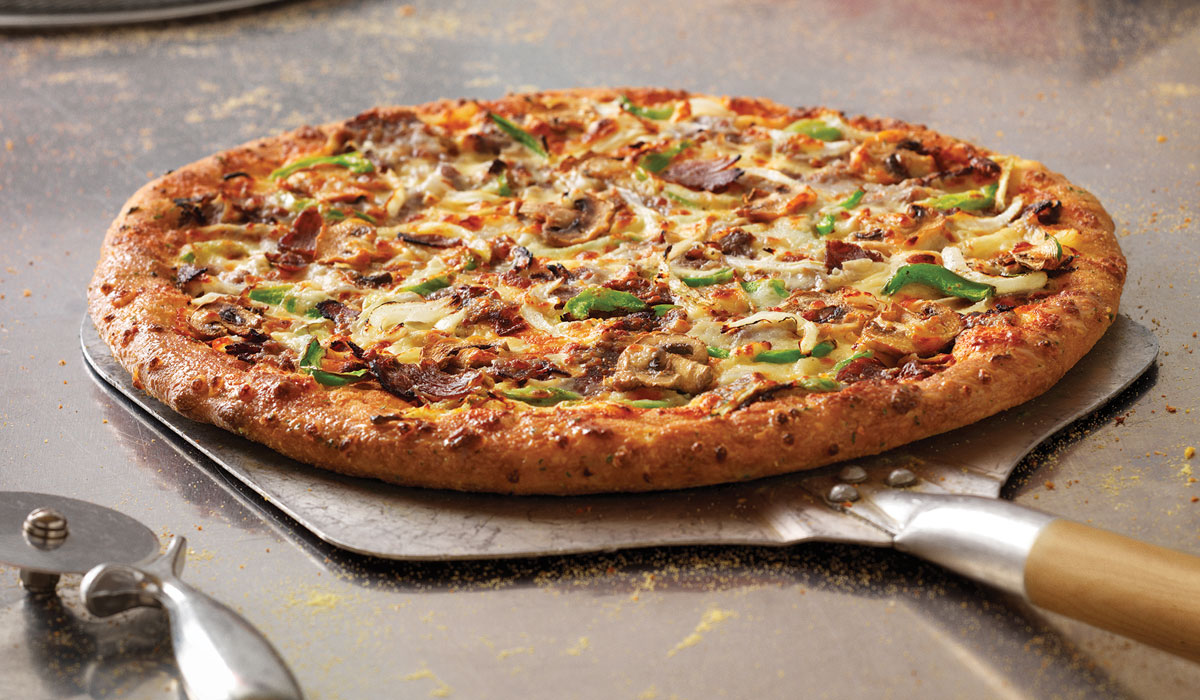To Domino’s CEO Russell Weiner, franchisee performance is a guaranteed predictor of how the brand will do in the future. Right now, it’s pointing toward good fortune.
U.S. operators earned $162,000 in average EBITDA per unit last year, up from $139,000 in 2022. Domino’s is targeting more than $170,000 in 2024.
The domestic footprint grew by 168 net new units in 2023. Ninety-two of them came in Q4, a little ahead of expectations. Domino’s ended last year with 6,854 U.S. locations and leapfrogged Burger King to become the sixth-largest quick-service restaurant in the country. It only trails Subway, Starbucks, McDonald’s, Dunkin, and Taco Bell. The next-biggest pizza chain is Pizza Hut, which had 6,593 restaurants at the end of 2023 and increased by a net of 32 stores.
This year, Domino’s projects 175 net new U.S. locations, which would put the system over 7,000. Unit growth will be relatively flat in the first half of 2024 compared to 2023 and will accelerate slightly in the back half.
READ MORE:
Is Domino’s Decision to Try Third-Party Delivery Paying Off?
Domino’s Unveils Four-Part Plan to Capture $7B in Sales and Nearly 50,000 Stores
Domino’s Confidence Isn’t Shaking Amid Slower Sales
Most of this growth is sourced internally. Last year, Domino’s added more than 60 new U.S. franchisees, which is the most in 15 years. Each one either started as a delivery driver or in another role within the company. One hundred and seventy potential new operators are either in franchise management school or have graduated—the last step before building or buying a unit. Also, 50 franchisees are waiting on store transfers.
“The 60 [new franchisees] to me means that we’ve got young up-and-comers within our system. It’s bigger than we have had in 15 years, which means they see a really positive future,” Weiner said during Domino’s Q4 earnings call.
Internationally, 543 net new stores opened in 2023, increasing unit count to 13,737. More than 80 percent of the 349 closures came from Domino’s Pizza Enterprises (franchisee in Australia, New Zealand, Japan, and other countries), Russia, and Brazil. Outside of those, no other market shuttered more than five stores.
A net of 925 openings are expected in 2024, and nearly half of that will come in India and China.
“Very confident in where we are with store openings international and we’ve been talking to our master franchisees and have good visibility to our expectations there,” said CFO Sandeep Reddy.
Domino’s foresees 1,100 net domestic and international openings in each of the next five years or 5,500 in total. That equals 7,700 U.S. shops by 2028 and 8,500-plus in the longer term, and 18,500 international restaurants by 2028 and 40,000-plus in the longer term. Combining those figures, Domino’s believes it has a total addressable market of about 50,000 units around the world.
Operator success is a significant portion of Domino’s new strategy, “Hungry for More.” The final word of that phrase serves as an acronym: Most Delicious Food, Operational Excellence, Renowned Value, and Enhanced by Best-in-Class Franchisees. The initiative involves “romancing the product” more often, like being on air with Pan Pizza advertising for the first time since 2014. It’s also about upgrading back-of-house processes, which occurred thanks to Domino’s Summer of Service training program last year.
In terms of value, the brand is repeatedly giving discounted promotions to customers, most recently a $6.99 carryout deal for a large two-topping pizza—something that hadn’t been offered since 2020. To Domino’s, value also means diversity of options, or more specifically, the launch of Uber Eats across the U.S. The third-party delivery service mixed 0.4 percent in the fourth quarter, but the chain believes it will rise to 3 percent by the end of 2024 as marketing and awareness ramps up.
“On speed of delivery, the biggest comparison we have is versus ourselves,” Weiner said. “And every day, we expect to get better than end of the day before. So we’re happy that we’re back to 2019 levels. We’re now moving more volume into that delivery network. And we’re doing everything we can not only to make sure that the delivery times are where they need to be, but more importantly, we haven’t talked a lot about this, is that the quality is there.”
U.S. same-store sales lifted 2.8 percent in Q4 and 1.6 percent in 2023. Comps were backed by delivery and carryout sales growth of 2 and 3.9 percent, respectively. The acceleration was also aided by transaction growth from the rebranded loyalty program, which debuted in September. There are two main changes: rewards members can earn 10 points on every order of $5 or more instead of $10 or more, and the tiers are 20, 40, and 60, meaning guests can begin redeeming points after two visits. The program succeeded in engaging lower-frequency users and carryout customers who typically spend less. The loyalty program has 33 million members. Three million were added in 2023, and two million of that came after the enhanced edition launched. Helping draw customers to loyalty was Emergency Pizza, which is essentially a BOGO offer allowing guests to get one free pizza after purchasing a meal.
For 2023, delivery accounted for 48 percent of transactions and 58 percent of sales, while carryout represented 52 percent of transactions and 42 percent of sales. The mix of sales and transactions shifted slightly to more carryout last year.
International comps increased 0.1 percent in Q4 and 1.7 percent in 2023. Deceleration was primarily driven by pressures in Europe and the war in the Middle East between Israel and Palestine. However, Domino’s noted that the Middle East represents less than 3 percent of operating income.








